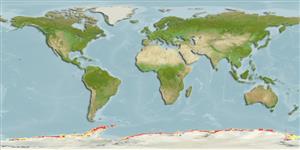>
Perciformes/Notothenioidei (Icefishes) >
Nototheniidae (Cod icefishes) > Trematominae
Etymology: Trematomus: Greek, trematos = hole + Greek, tomo = section, cut (Ref. 45335); newnesi: newnesi named after Sir George Newnes, British newspaper publisher who sponsored Borchgrevinck's Expedition of 1899 (Ref. 11892).
More on author: Boulenger.
Environment: milieu / climate zone / depth range / distribution range
Ecología
marino demersal; rango de profundidad 0 - 400 m (Ref. 11892). Polar; 60°S - 78°S
Southern Ocean: East Antarctic, Weddell Sea, West coast of Antarctic Peninsula, South Shetland Islands, Elephant Island, South Orkney Islands, Mac Robertson, George V, Queen Mary, Adelie Coasts, Davis Sea and Ross Sea.
Tamaño / Peso / Age
Maturity: Lm ? range ? - ? cm
Max length : 24.5 cm TL macho / no sexado; (Ref. 58849)
Espinas dorsales (total): 5 - 8; Radios blandos dorsales (total): 29-38; Radios blandos anales: 29 - 36
Found in shallow near shore areas and more commonly in the intertidal zone. Adults feed mainly on amphipods, polychaetes, gastropods, isopods, copepods, and euphausiids (E. superba). Often seen feeding in the water column or at the undersurface of ice.
Life cycle and mating behavior
Madurez | Reproducción | Puesta | Huevos | Fecundidad | Larva
Dewitt, H.H., P.C. Heemstra and O. Gon, 1990. Nototheniidae. p. 279-331. In O. Gon and P.C. Heemstra (eds.) Fishes of the Southern Ocean. J.L.B. Smith Institute of Ichthyology, Grahamstown, South Africa. (Ref. 5179)
IUCN Red List Status (Ref. 130435)
Threat to humans
Harmless
Human uses
Pesquerías: sin interés
Más información
ReferenciasAcuiculturaPerfil de acuiculturaRazasGenéticaElectrophoresesheritabilidadEnfermedadesProcesamientoNutrientsMass conversion
ColaboradoresImágenesStamps, Coins Misc.SonidosCiguateraVelocidadTipo de nataciónSuperficie branquialOtolitosCerebrosVisión
Herramientas
Special reports
Download XML
Fuentes de Internet
Estimates based on models
Preferred temperature (Ref.
123201): -1.8 - -0.4, mean -1.4 °C (based on 237 cells).
Phylogenetic diversity index (Ref.
82804): PD
50 = 0.5005 [Uniqueness, from 0.5 = low to 2.0 = high].
Bayesian length-weight: a=0.00537 (0.00280 - 0.01029), b=3.24 (3.07 - 3.41), in cm total length, based on LWR estimates for this Genus-body shape (Ref.
93245).
Nivel trófico (Ref.
69278): 3.2 ±0.2 se; based on diet studies.
Generation time: 3.1 ( na - na) years. Estimated as median ln(3)/K based on 2
growth studies.
Resiliencia (Ref.
120179): Medio, población duplicada en un tiempo mínimo de 1.4-4.4 años (Fec = 2,300-12,200).
Fishing Vulnerability (Ref.
59153): Low to moderate vulnerability (28 of 100).
